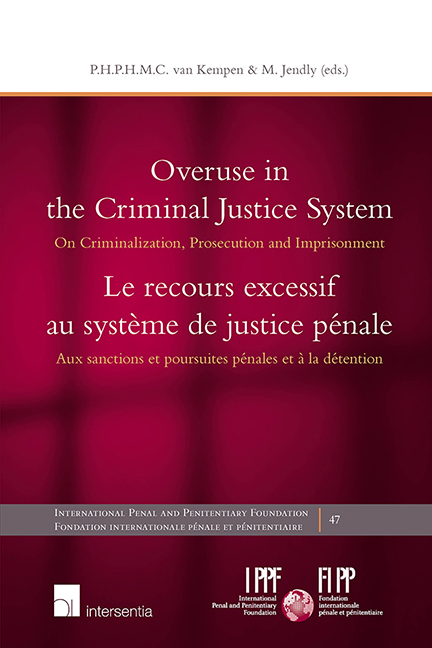Book contents
- Frontmatter
- Dedication
- Contents
- Acknowledgements
- Remerciements
- PART I INTRODUCTORY SYNTHESIS AND ANALYSES 1ÈRE PARTIE. SYNTHÈSE ET ANALYSES INTRODUCTIVES
- PART II THEMES 2ÈME PARTIE. THÈMES
- PART III NATIONAL REPORTS 3ÈME PARTIE. RAPPORTS NATIONAUX
- Overuse in the Criminal Justice System in Argentina
- Le recours au système de justice pénale en Belgique: état des lieux et perspectives
- Overuse of Criminal Law in Finland
- Overuse in the Criminal Justice System in Germany
- Overuse in the Criminal Justice System in Greece
- Overusing the Criminal Justice System: the Case of Ireland
- Overuse in the Criminal Justice System in Japan
- Tendencies of Overuse in Criminal Law Policy and Criminal Law Enforcement in the Netherlands
- Overuse in the Criminal Justice System in New Zealand
- Overuse in the Criminal Justice System in Nigeria
- Overuse in the Criminal Justice System in Poland
- Overuse in the Russian Criminal Justice System
- Overuse in the Criminal Justice System in Spain
- Recourt-on de manière excessive au système pénal en Suisse?
- Overuse of the Criminal Justice System in Taiwan
- Overuse and Underuse of the United States Criminal Justice System in the Area of Business Crimes
- The International Penal and Penitentiary Foundation: history and purpose
- La Fondation internationale pénale et pénitentiaire: histoire et objectif
- The IPPF Series
Overuse of Criminal Law in Finland
from PART III - NATIONAL REPORTS 3ÈME PARTIE. RAPPORTS NATIONAUX
Published online by Cambridge University Press: 26 June 2019
- Frontmatter
- Dedication
- Contents
- Acknowledgements
- Remerciements
- PART I INTRODUCTORY SYNTHESIS AND ANALYSES 1ÈRE PARTIE. SYNTHÈSE ET ANALYSES INTRODUCTIVES
- PART II THEMES 2ÈME PARTIE. THÈMES
- PART III NATIONAL REPORTS 3ÈME PARTIE. RAPPORTS NATIONAUX
- Overuse in the Criminal Justice System in Argentina
- Le recours au système de justice pénale en Belgique: état des lieux et perspectives
- Overuse of Criminal Law in Finland
- Overuse in the Criminal Justice System in Germany
- Overuse in the Criminal Justice System in Greece
- Overusing the Criminal Justice System: the Case of Ireland
- Overuse in the Criminal Justice System in Japan
- Tendencies of Overuse in Criminal Law Policy and Criminal Law Enforcement in the Netherlands
- Overuse in the Criminal Justice System in New Zealand
- Overuse in the Criminal Justice System in Nigeria
- Overuse in the Criminal Justice System in Poland
- Overuse in the Russian Criminal Justice System
- Overuse in the Criminal Justice System in Spain
- Recourt-on de manière excessive au système pénal en Suisse?
- Overuse of the Criminal Justice System in Taiwan
- Overuse and Underuse of the United States Criminal Justice System in the Area of Business Crimes
- The International Penal and Penitentiary Foundation: history and purpose
- La Fondation internationale pénale et pénitentiaire: histoire et objectif
- The IPPF Series
Summary
INTRODUCTION
Finland is a small Nordic country with a population of 5.4 million. The Finnish juridical system is manifestly rooted in western, continental legal culture with strong influence from neighbouring Nordic Countries. Today Finland profiles itself – together with the other Nordic countries Denmark, Iceland, Norway and Sweden – as a county with internationally high level of social security and equality, high levels of social trust and political legitimacy, and low levels of penal repression. However, this has not always been the case. During the last Century, Finland has experienced three wars (the 1918 Civil War and the two wars against Soviet Union between 1939 and 1944). These crises have left their marks in the Finnish society and its criminal policy. The trends in prison rates have been more turbulent than presumably in any other Westerns European country, leading to a gross overuse of imprisonment in connection with the societal crisis during the first half of the 1990s. At times imprisonment rates reached the levels of 250-300 / 100,000 inhabitants, five to six times higher than those in Denmark, Sweden and Norway. Figure 1 displays trends in imprisonment rates in four Nordic countries in 1900-2014.
Three “imprisonment peaks” may be detected during the first half of the last century. In the aftermath of the civil war in 1918 and 1919, Finnish prisons were filled with political prisoners. During the prohibition period in the shift of the 1920/30s and followed by the recession in the 1930s, prohibition-related crime and property offences increased, resulting in severe overcrowding in the Finnish prisons. The third peak appeared in the aftermath of the Second World War, partly consisting of war-time offences, partly of the post war crime wave.
In the 1950s, a period of normalization, known as the “age of reconstruction”, began in Finland. The country was recovering from the damages of the two World Wars and the burden of paying war compensation to the Soviet Union, while at the same time establishing the industrial infrastructure which formed the foundations of the forthcoming welfare state. Finland was catching up with her Nordic neighbours that had survived the first half of the 20th century with significantly smaller damages.
- Type
- Chapter
- Information
- Overuse in the Criminal Justice SystemOn Criminalization, Prosecution and Imprisonment, pp. 293 - 332Publisher: IntersentiaPrint publication year: 2019



